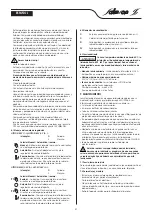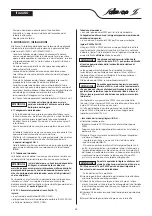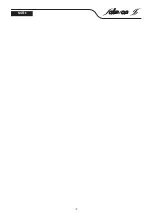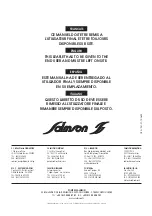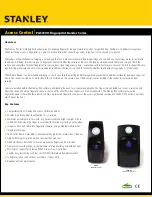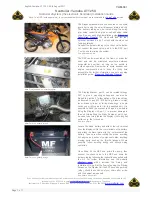
25
and turned through 180° using a suitable screwdriver (
FIG. 15
).
6.1 Switchgear operation :
LIFTSON M-V (1~) and LIFTSON M-V/L-V (3~) :
ON/OFF switch
:
O
OFF
I
ON
Manual/Automatic switch :
Manual
: the unit will continue to run for as long as the
button is pressed.
Automatic
: the unit operation is controlled by the
internal vessel level regulator.
Horn switch
: If the high-water alarm is triggered by the
float switch the acoustic signal can be muted by pressing
the button.
This will not affect the floating alarm contact.
LIFTSON M-2V/L-2V (1~) and M-2V/L-2V (3~) :
ON/OFF switch
:
O
OFF
I
ON
Manual/Automatic switch :
Pump 1
: the unit will continue to run for as long as the
button is pressed.
Automatic
: the unit operation is controlled by the
internal vessel level regulator.
Pump 2
: the unit will continue to run for as long as the
button is pressed.
Horn switch
: If the high-water alarm is triggered by the
float switch the acoustic signal can be muted by pressing
the button.
This will not affect the floating alarm contact.
6.2 Display elements :
O
Rotational signal, lights up (red) when direction of rotation
is wrong (3~ only).
O
Operation signal, lights (green) when unit is ready for use.
P1
Pump 1 defect, lights (red) for excess current and winding
protection contact (3~ only).
P2
Pump 2 defect, lights red for excess current and winding
protection contact (~3 only).
6.3 Operation
This unit is designed for media temperatures of up
to 40 °C or for short periods up to 60 °C, at
ambient temperatures up to 40°C. Dry running should be avoided,
as this could destroy the pump’s mechanical seal.
•
Type of operation
: Intermittent operation S3-15%.
The unit is not designed for continuous operation !
•
Admissible operating frequency
:
M-V/L-V : 30/hour ; M-2V/L-2V : 60/hour
•
Flooding
:The LIFTSON units are flood-proof.
Flood height : maxi 2 mWS,
Flood time : max. 7 days.
7. MAINTENANCE
All maintenance work to sewage lifting units must be carried out by
specialist staff in accordance with EN 12056-4. The maintenance
intervals must not exceed :
• 4 per year for commercial operations.
• 2 per year for units in multiple-family dwellings.
• 1 per year for units in single-family dwellings.
• In order to avoid infection, maintenance work should always be
carried out using protective gloves.
• The operator is responsible for ensuring that inspection and
assembly are carried out by authorised and qualified personnel
who have studied the operating instructions closely.
• By drawing up a maintenance plan, costly repairs can be avoided
with a minimum of maintenance expense and fault-free pump
operation obtained. Salmson Service is available for all initial
commissioning and maintenance work.
• A record is to be kept of any maintenance.
Before carrying out any maintenance work, switch off the
pump and ensure that it cannot be switched on again in an
unauthorised manner. Never carry out work on a running
pump.
7.1 Decommissioning
After long periods out of use we recommend checking the pump for
impurities and if necessary cleaning it.
7.2 Disassembly and assembly
- Disassembly and assembly should only be carried out by qualified
personnel !
- Disconnect power supply !
- Close gate valve (inlet and pressure piping).
- Drain collecting vessel (e.g. using manual diaphragm pump).
- Then screw on inspection cover for cleaning.
If a used unit or parts thereof are to be returned for repairs,
they must be drained and cleaned prior to transport for
reasons of hygiene. In addition, all parts which may be
touched are to be disinfected (spray disinfection). The parts must be
tightly sealed in tearproof, sufficiently large plastic bags and
packed in leakproof packaging. They must be returned
immediately via authorised carriers.
ENGLISH
ATTENTION !
P1
P2





















